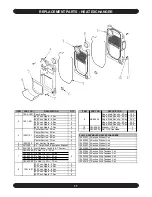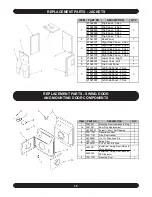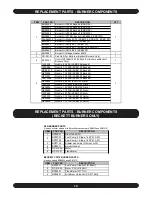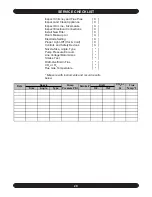
14
!
!
!
!
!
!
Before seasonal start up it is advisable to have a
competent service agency check the boiler for soot
and scale in the flues, change oil filter and nozzle,
clean the burner and readjust burner input rate to
maintain high operating efficiency.
On steam boilers make certain the boiler is filled to
the water line as indicated in Figure 12. The gauge
cocks should be normally open. To remove dirt from
the gauge glass the petcock may be opened to flush
out the glass.
WARNING
Discharge may be boiling hot water.
The radiator valves on a one-pipe steam system
must be either wide open or tightly shut. Do not
attempt to regulate room temperature by partially
closing the radiator valve.
Air vents on steam radiators and the supply main
release air from the system. If radiators do not heat
satisfactorily, make sure the air vents are clean and
operational.
The lever of the pressure relief valve on the boiler
(Figure 12)
should be operated periodically to make
sure that it is functioning properly.
WARNING
Discharge will be boiling hot water and steam.
The safety valve should open before the steam
pressure exceeds the 15 lb. reading on the gauge.
(Figure 12)
If this pressure is exceeded and the
safety valve does not open, it must be replaced. If the
safety valve leaks steam when the boiler is operating
at normal pressures, it should be immediately
replaced. Corrosion can build up rapidly at the valve
seat and prevent its functioning as a safety device.
If the water in a steam boiler appears to be dirty or
oily, or the water level in the gauge glass fluctuates
considerably, the boiler should be cleaned. A com-
petent service person will use approved cleaning
compounds and properly clean and flush out the
boiler. He/she should also clean or replace air vents
and traps, clean flue passages and check for proper
operation of all controls and safety devices.
The venting system should be inspected at the start
of each heating season. Check the vent pipe from
the boiler to the chimney for signs of deterioration by
rust or sagging joints. Repair if necessary.
Impurities in boiler water of a steam boiler may cause
foaming and an unsteady water line, or prevent
steam generation. They may result in objectionable
odors escaping from the vents on water boilers. This
condition is caused by oil, grease, and sediment
from pipe fittings collecting within the boiler and can
be remedied only by giving the boiler a thorough
cleaning.
BOILERS SHOULD BE CLEANED BY SKIMMING
OR BLOWING DOWN.
CAUTION
The boiler should not be left unattended dur-
ing the cleaning process.
SKIMMING OFF IMPURITIES
Some of the impurities in the boiler water will float on
the water and must be skimmed off.
With the boiler empty and cool, slowly begin to add
water. After water has entered boiler - never before
- turn “on” oil burner and adjust water flow so that the
water being added is kept just below boiling point.
Avoid boiling and turbulence.
Gradually raise hot water level to skimming hole
(Figure 6)
installed on the rear section of the boiler
being careful not to raise it above the opening of the
hole. Skim until there are no impurities. Repeat the
process if necessary.
Water may be checked to make sure it is free from
oil by drawing off a sample at the skimming hole. If
the sample is reasonably free from oil, it will not froth
when boiled on stove. This test does not indicate the
amount of sediment which may lay in the bottom of
the boiler. It is therefore necessary that the boiler be
further cleaned by “blowing down.”
BLOWING DOWN THE BOILER
Before blowing down the boiler, fill it to the water line.
Turn on burner and allow five pounds of steam
MAINTENANCE PROCEDURES






































